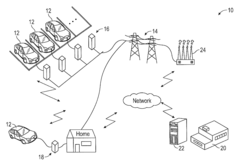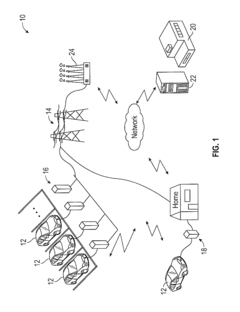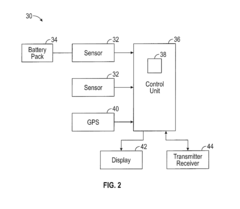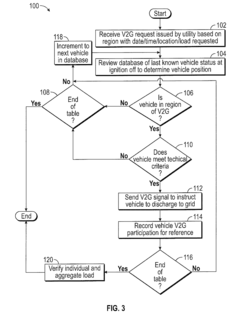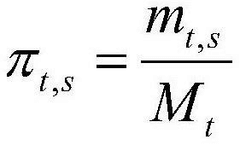Evaluating Standards Compliance in Vehicle-to-Grid Technologies
SEP 23, 20259 MIN READ
Generate Your Research Report Instantly with AI Agent
Patsnap Eureka helps you evaluate technical feasibility & market potential.
V2G Technology Background and Objectives
Vehicle-to-Grid (V2G) technology represents a transformative approach to energy management that has evolved significantly over the past decade. The concept emerged in the late 1990s but gained substantial momentum after 2010 as electric vehicle (EV) adoption increased and smart grid technologies matured. V2G enables bidirectional power flow between electric vehicles and the electricity grid, allowing EVs to not only consume energy but also return it to the grid when needed, effectively turning vehicles into mobile energy storage units.
The evolution of V2G technology has been driven by several converging factors: the global push toward renewable energy integration, increasing grid instability challenges, and the rapid growth of the electric vehicle market. Early V2G implementations focused primarily on unidirectional controlled charging (V1G), but have progressively advanced toward full bidirectional capabilities that enable services such as peak shaving, frequency regulation, and voltage support.
Current technological trends indicate a move toward more sophisticated V2G systems with enhanced communication protocols, improved power electronics, and more efficient energy management algorithms. The integration of artificial intelligence and machine learning is enabling predictive capabilities that optimize charging and discharging cycles based on grid demands, electricity prices, and user behavior patterns.
The primary objective of V2G technology evaluation is to ensure seamless interoperability between vehicles, charging infrastructure, and grid systems across different manufacturers and regions. This requires rigorous standards compliance assessment to verify that V2G implementations adhere to established protocols for communication, safety, and performance.
Technical goals for V2G standards compliance include validating communication interfaces according to ISO 15118, IEC 61851, and IEEE 2030.5 standards; ensuring grid interconnection requirements meet IEEE 1547 and regional grid codes; and confirming cybersecurity measures align with IEC 62351 and NIST frameworks. Additionally, evaluations must verify that power quality metrics comply with IEEE 519 and IEC 61000 standards.
Beyond technical compliance, V2G technology aims to create value across multiple stakeholders: for utilities by providing grid services and demand response capabilities; for vehicle owners through potential revenue streams and reduced total cost of ownership; and for society through enhanced renewable energy integration and reduced carbon emissions.
As V2G technology continues to mature, the focus is increasingly shifting toward standardization and interoperability to enable mass-market adoption and realize the full potential of this technology in supporting the transition to a more sustainable and resilient energy ecosystem.
The evolution of V2G technology has been driven by several converging factors: the global push toward renewable energy integration, increasing grid instability challenges, and the rapid growth of the electric vehicle market. Early V2G implementations focused primarily on unidirectional controlled charging (V1G), but have progressively advanced toward full bidirectional capabilities that enable services such as peak shaving, frequency regulation, and voltage support.
Current technological trends indicate a move toward more sophisticated V2G systems with enhanced communication protocols, improved power electronics, and more efficient energy management algorithms. The integration of artificial intelligence and machine learning is enabling predictive capabilities that optimize charging and discharging cycles based on grid demands, electricity prices, and user behavior patterns.
The primary objective of V2G technology evaluation is to ensure seamless interoperability between vehicles, charging infrastructure, and grid systems across different manufacturers and regions. This requires rigorous standards compliance assessment to verify that V2G implementations adhere to established protocols for communication, safety, and performance.
Technical goals for V2G standards compliance include validating communication interfaces according to ISO 15118, IEC 61851, and IEEE 2030.5 standards; ensuring grid interconnection requirements meet IEEE 1547 and regional grid codes; and confirming cybersecurity measures align with IEC 62351 and NIST frameworks. Additionally, evaluations must verify that power quality metrics comply with IEEE 519 and IEC 61000 standards.
Beyond technical compliance, V2G technology aims to create value across multiple stakeholders: for utilities by providing grid services and demand response capabilities; for vehicle owners through potential revenue streams and reduced total cost of ownership; and for society through enhanced renewable energy integration and reduced carbon emissions.
As V2G technology continues to mature, the focus is increasingly shifting toward standardization and interoperability to enable mass-market adoption and realize the full potential of this technology in supporting the transition to a more sustainable and resilient energy ecosystem.
Market Analysis for V2G Integration
The Vehicle-to-Grid (V2G) market is experiencing significant growth as the integration of electric vehicles (EVs) into the power grid becomes increasingly important for grid stability and renewable energy utilization. Current market projections indicate that the global V2G technology market is expected to reach $17.43 billion by 2027, growing at a compound annual growth rate of 48% from 2020. This growth is driven by the increasing adoption of EVs, government initiatives promoting clean energy, and the need for grid flexibility.
The primary market segments for V2G integration include residential, commercial, and utility applications. Residential V2G systems are gaining traction in regions with high electricity costs and time-of-use pricing structures, allowing homeowners to optimize energy consumption and reduce utility bills. Commercial applications are emerging in fleet operations, where businesses can leverage V2G to manage energy costs and potentially generate revenue through grid services.
Geographically, Europe leads the V2G market adoption, with countries like Denmark, the Netherlands, and the UK implementing pilot projects and supportive regulatory frameworks. North America follows, with significant investments in V2G infrastructure in California and other progressive states. The Asia-Pacific region, particularly Japan and South Korea, is rapidly developing V2G capabilities aligned with their robust automotive manufacturing sectors.
Consumer demand for V2G technology is influenced by several factors, including financial incentives, environmental consciousness, and energy independence concerns. Early adopters are primarily environmentally conscious consumers and technology enthusiasts, but mainstream adoption faces challenges related to awareness, perceived complexity, and concerns about battery degradation.
Market research indicates that successful V2G business models must address value distribution among stakeholders, including EV owners, utilities, aggregators, and charging infrastructure providers. Revenue streams for V2G participants include energy arbitrage, frequency regulation, demand response, and capacity markets, with frequency regulation currently offering the highest value proposition.
Key market drivers include the increasing penetration of renewable energy sources, which creates greater grid variability and the need for flexible resources like V2G. Additionally, declining battery costs, improving battery technology, and the development of bidirectional charging infrastructure are accelerating market growth.
Barriers to market expansion include regulatory uncertainties, technical standardization challenges, and the need for more sophisticated energy management systems. The lack of unified standards for V2G communication protocols and grid interconnection requirements creates market fragmentation and increases implementation costs, highlighting the critical importance of standards compliance evaluation in this rapidly evolving sector.
The primary market segments for V2G integration include residential, commercial, and utility applications. Residential V2G systems are gaining traction in regions with high electricity costs and time-of-use pricing structures, allowing homeowners to optimize energy consumption and reduce utility bills. Commercial applications are emerging in fleet operations, where businesses can leverage V2G to manage energy costs and potentially generate revenue through grid services.
Geographically, Europe leads the V2G market adoption, with countries like Denmark, the Netherlands, and the UK implementing pilot projects and supportive regulatory frameworks. North America follows, with significant investments in V2G infrastructure in California and other progressive states. The Asia-Pacific region, particularly Japan and South Korea, is rapidly developing V2G capabilities aligned with their robust automotive manufacturing sectors.
Consumer demand for V2G technology is influenced by several factors, including financial incentives, environmental consciousness, and energy independence concerns. Early adopters are primarily environmentally conscious consumers and technology enthusiasts, but mainstream adoption faces challenges related to awareness, perceived complexity, and concerns about battery degradation.
Market research indicates that successful V2G business models must address value distribution among stakeholders, including EV owners, utilities, aggregators, and charging infrastructure providers. Revenue streams for V2G participants include energy arbitrage, frequency regulation, demand response, and capacity markets, with frequency regulation currently offering the highest value proposition.
Key market drivers include the increasing penetration of renewable energy sources, which creates greater grid variability and the need for flexible resources like V2G. Additionally, declining battery costs, improving battery technology, and the development of bidirectional charging infrastructure are accelerating market growth.
Barriers to market expansion include regulatory uncertainties, technical standardization challenges, and the need for more sophisticated energy management systems. The lack of unified standards for V2G communication protocols and grid interconnection requirements creates market fragmentation and increases implementation costs, highlighting the critical importance of standards compliance evaluation in this rapidly evolving sector.
V2G Standards Landscape and Challenges
The Vehicle-to-Grid (V2G) standards landscape presents a complex ecosystem of technical protocols, communication frameworks, and regulatory requirements that govern the bidirectional flow of electricity and information between electric vehicles and the power grid. Currently, this landscape is characterized by regional fragmentation, with different standards bodies developing frameworks that address specific aspects of V2G integration.
In North America, the IEEE 2030.5 and SAE J3072 standards have emerged as prominent frameworks for V2G communications and interconnection requirements. Meanwhile, the European landscape is dominated by ISO 15118, which provides a comprehensive communication protocol suite for the vehicle-to-grid interface, with particular emphasis on secure authentication and payment processes.
A significant challenge in the V2G standards environment is interoperability between different systems and protocols. Many existing standards were developed independently, resulting in compatibility issues that hinder seamless integration across different charging infrastructures, vehicle models, and grid management systems. This fragmentation increases implementation costs and creates market barriers for technology providers.
Cybersecurity represents another critical challenge, as bidirectional energy flow introduces new vulnerabilities in both the grid and vehicle systems. Current standards vary significantly in their security requirements, creating inconsistent protection levels across the V2G ecosystem. The ISO 15118-2 standard addresses some security concerns through its Plug & Charge functionality, but comprehensive security frameworks that span the entire V2G communication chain remain underdeveloped.
Grid stability and power quality considerations are inadequately addressed in many existing standards. As V2G deployment scales, the potential impact of harmonized charging and discharging patterns on grid stability becomes increasingly significant, yet current standards provide limited guidance on managing these effects.
Regulatory compliance adds another layer of complexity, with standards needing to align with regional grid codes, utility requirements, and energy market regulations. The IEC 61851 and IEC 63110 standards attempt to address these aspects but face challenges in keeping pace with rapidly evolving regulatory landscapes.
The certification and testing frameworks for V2G compliance remain immature, with limited standardized methodologies to verify adherence to technical requirements. This creates uncertainty for manufacturers and delays market adoption of V2G technologies.
Addressing these challenges requires greater international coordination among standards bodies, increased industry participation in standards development, and more comprehensive testing frameworks that can validate compliance across the complex V2G ecosystem.
In North America, the IEEE 2030.5 and SAE J3072 standards have emerged as prominent frameworks for V2G communications and interconnection requirements. Meanwhile, the European landscape is dominated by ISO 15118, which provides a comprehensive communication protocol suite for the vehicle-to-grid interface, with particular emphasis on secure authentication and payment processes.
A significant challenge in the V2G standards environment is interoperability between different systems and protocols. Many existing standards were developed independently, resulting in compatibility issues that hinder seamless integration across different charging infrastructures, vehicle models, and grid management systems. This fragmentation increases implementation costs and creates market barriers for technology providers.
Cybersecurity represents another critical challenge, as bidirectional energy flow introduces new vulnerabilities in both the grid and vehicle systems. Current standards vary significantly in their security requirements, creating inconsistent protection levels across the V2G ecosystem. The ISO 15118-2 standard addresses some security concerns through its Plug & Charge functionality, but comprehensive security frameworks that span the entire V2G communication chain remain underdeveloped.
Grid stability and power quality considerations are inadequately addressed in many existing standards. As V2G deployment scales, the potential impact of harmonized charging and discharging patterns on grid stability becomes increasingly significant, yet current standards provide limited guidance on managing these effects.
Regulatory compliance adds another layer of complexity, with standards needing to align with regional grid codes, utility requirements, and energy market regulations. The IEC 61851 and IEC 63110 standards attempt to address these aspects but face challenges in keeping pace with rapidly evolving regulatory landscapes.
The certification and testing frameworks for V2G compliance remain immature, with limited standardized methodologies to verify adherence to technical requirements. This creates uncertainty for manufacturers and delays market adoption of V2G technologies.
Addressing these challenges requires greater international coordination among standards bodies, increased industry participation in standards development, and more comprehensive testing frameworks that can validate compliance across the complex V2G ecosystem.
Current V2G Compliance Solutions
01 V2G Communication Protocol Standards
Vehicle-to-Grid technologies require standardized communication protocols to ensure interoperability between electric vehicles and power grids. These standards define how data is exchanged between vehicles and grid infrastructure, including authentication, authorization, and transaction protocols. Compliance with these communication standards is essential for secure and efficient energy transfer operations, enabling vehicles to respond to grid signals for charging and discharging based on grid needs.- V2G Communication Protocol Standards: Vehicle-to-Grid (V2G) technologies require standardized communication protocols to ensure interoperability between electric vehicles and the power grid. These standards define how data is exchanged between vehicles, charging stations, and grid operators, enabling seamless integration and operation. Compliance with these communication protocols is essential for secure, reliable, and efficient V2G operations across different manufacturers and regions.
- Grid Integration and Power Management Standards: Standards for grid integration and power management in V2G systems ensure that electric vehicles can safely and efficiently deliver power back to the grid. These standards address power quality, voltage regulation, frequency control, and load balancing requirements. Compliance with these standards helps prevent grid instability and ensures that V2G systems contribute positively to grid resilience while protecting both vehicle and grid infrastructure from damage.
- V2G Security and Authentication Standards: Security standards for V2G technologies establish requirements for data protection, user authentication, and secure transactions between vehicles and the grid. These standards address cybersecurity threats, privacy concerns, and financial transaction security in V2G systems. Compliance ensures that sensitive user data is protected, unauthorized access is prevented, and the integrity of the power grid is maintained against potential cyber attacks.
- V2G Certification and Testing Frameworks: Certification and testing frameworks for V2G technologies provide methodologies to verify compliance with relevant standards. These frameworks include test procedures, validation methods, and certification processes that ensure V2G systems meet regulatory requirements before deployment. Standardized testing helps identify interoperability issues, safety concerns, and performance limitations, facilitating the development of reliable and compliant V2G solutions.
- V2G Market and Regulatory Compliance: Market and regulatory compliance standards for V2G technologies address the business, legal, and policy aspects of vehicle-grid integration. These standards cover electricity market participation rules, pricing mechanisms, energy trading protocols, and regulatory reporting requirements. Compliance with these standards enables fair compensation for grid services provided by electric vehicles and ensures that V2G operations adhere to regional energy policies and regulations.
02 Grid Integration and Energy Management Standards
Standards for integrating electric vehicles into the power grid focus on energy management systems that balance grid load and optimize energy distribution. These standards address how vehicles can provide ancillary services to the grid, including frequency regulation, voltage support, and demand response. Compliance ensures that V2G systems can effectively participate in energy markets while maintaining grid stability and reliability through standardized energy flow management and control mechanisms.Expand Specific Solutions03 Safety and Security Compliance Requirements
V2G technology standards include critical safety and security requirements to protect both the electrical grid and vehicle systems. These standards cover electrical safety during bidirectional power flow, cybersecurity protocols to prevent unauthorized access, and data protection measures. Compliance with these standards ensures that V2G systems can operate without compromising grid security or vehicle integrity, with proper authentication mechanisms and secure transaction processing.Expand Specific Solutions04 Interoperability and Testing Standards
Interoperability standards ensure that V2G systems from different manufacturers can work together seamlessly. These standards define testing procedures, certification requirements, and validation methodologies to verify compliance. They establish common interfaces, data formats, and operational parameters that enable cross-vendor compatibility and system integration. Standardized testing frameworks help validate that V2G equipment meets performance requirements and can operate within the broader ecosystem.Expand Specific Solutions05 Regulatory Compliance and Certification Frameworks
Regulatory frameworks govern how V2G technologies must comply with regional and international standards. These include certification processes, compliance reporting requirements, and regulatory oversight mechanisms. Standards in this category address how V2G systems must adhere to grid codes, energy market regulations, and environmental policies. They establish the legal and regulatory foundation for V2G deployment, including requirements for certification, monitoring, and verification of compliance.Expand Specific Solutions
Key Industry Stakeholders and Competitors
The Vehicle-to-Grid (V2G) technology market is currently in its early growth phase, characterized by increasing standardization efforts amid expanding market potential. The global V2G market is projected to reach approximately $17-20 billion by 2027, with a CAGR of around 48%. Major automotive manufacturers including Volkswagen AG, BMW, GM, and Toyota are actively developing V2G-compliant systems, while technology providers like Qualcomm and Siemens are focusing on communication protocols. Traditional automakers are collaborating with utility companies such as State Grid Corporation of China to establish interoperability standards. The technology maturity varies significantly, with companies like Continental, Bosch, and Ford demonstrating advanced bidirectional charging capabilities, while newer entrants like Xiaomi and Karma Automotive are still developing their V2G compliance frameworks.
QUALCOMM, Inc.
Technical Solution: Qualcomm has developed the "Halo V2G Compliance Platform" that focuses on wireless power transfer technologies for V2G applications while ensuring standards compliance. Their solution incorporates dedicated V2G chipsets that support multiple communication protocols including ISO 15118, CHAdeMO, and SAE J2847. The platform features Qualcomm's proprietary compliance verification system that continuously monitors power quality parameters, grid synchronization, and communication integrity during bidirectional energy transfer. Their technology implements real-time adaptive algorithms that automatically adjust to different grid codes and regulatory requirements across regions, enabling global deployment with localized compliance. Qualcomm's solution includes hardware security modules that authenticate grid connections and encrypt data exchanges, addressing cybersecurity requirements in modern V2G standards. The platform provides comprehensive diagnostic capabilities and generates compliance reports that can be submitted to certification authorities, streamlining the approval process for vehicle manufacturers and charging infrastructure operators.
Strengths: Industry-leading wireless charging technology combined with robust communication capabilities. Their semiconductor expertise enables highly integrated, energy-efficient solutions with strong security features. Weaknesses: Relatively higher implementation costs compared to wired solutions. Wireless V2G technology faces additional regulatory hurdles in some markets regarding electromagnetic compatibility and safety standards.
State Grid Corp. of China
Technical Solution: State Grid has developed a comprehensive V2G compliance framework based on their extensive power grid infrastructure. Their solution integrates IEEE 2030.5 and ISO 15118 standards for vehicle-grid communication protocols, ensuring interoperability across different EV models and charging equipment. The company has implemented a three-tier verification system that evaluates hardware compatibility, communication protocol adherence, and grid integration performance. Their platform includes real-time monitoring capabilities that track power flow bidirectionally between vehicles and the grid, with automated compliance checks against national and international standards. State Grid has deployed large-scale pilot projects across multiple provinces in China, demonstrating successful V2G operations with over 10,000 connected vehicles providing grid services while maintaining strict compliance with both energy and automotive regulatory requirements.
Strengths: Leverages extensive existing grid infrastructure and has unparalleled access to the Chinese market for large-scale implementation. Their system benefits from direct integration with national grid operations. Weaknesses: Solutions may be overly tailored to Chinese regulatory environment, potentially limiting international applicability. Heavy focus on centralized control may reduce flexibility for third-party innovations.
Critical Standards and Protocols Analysis
Priority based vehicle control strategy
PatentActiveUS20160075247A1
Innovation
- A method and system that prioritize V2G requests by determining which vehicles in a specific geographic region meet criteria established to reduce battery degradation, using historical and current data to select vehicles for participation, thereby limiting the number of charge and discharge cycles and extending the battery life.
Vehicle-to-grid optimization control method for balancing battery aging cost and electricity market income
PatentWO2024192972A1
Innovation
- By obtaining relevant status data of electric vehicles, predicting frequency modulation signal distribution, and constructing the objective function of the optimal bidding problem, combined with battery aging costs and market profit constraints, stochastic optimization methods are used to solve the power allocation problem of electric vehicle clusters and optimize charging management strategies.
Regulatory Framework Impact on V2G Deployment
The regulatory landscape surrounding Vehicle-to-Grid (V2G) technologies represents a complex matrix of policies, standards, and guidelines that significantly influence deployment rates across different regions. Current regulatory frameworks exhibit substantial variation globally, with some jurisdictions actively promoting V2G through supportive policies while others maintain barriers that impede implementation. These disparities create an uneven adoption pattern that directly impacts market development.
In leading markets such as the European Union, regulatory initiatives like the Clean Energy Package have established foundational frameworks that recognize energy storage as a distinct market activity, thereby enabling V2G participation in electricity markets. Similarly, California's Rule 21 and FERC Order 2222 in the United States have created pathways for distributed energy resources, including V2G systems, to participate in wholesale electricity markets.
However, significant regulatory challenges persist. Many jurisdictions maintain double taxation structures where energy is taxed both when drawn from and returned to the grid, creating economic disincentives for V2G adoption. Additionally, outdated grid codes often fail to accommodate bidirectional energy flows, requiring substantial revisions to technical standards and interconnection requirements.
The fragmentation of regulatory approaches across different regions creates compliance complexities for V2G technology providers and automotive manufacturers seeking to deploy standardized solutions globally. This regulatory heterogeneity necessitates customized compliance strategies for each market, increasing development costs and slowing deployment timelines.
Recent regulatory trends indicate a gradual shift toward more supportive frameworks. Several jurisdictions have introduced regulatory sandboxes to test V2G technologies under controlled conditions before establishing permanent rules. These experimental approaches allow regulators to gather empirical data on grid impacts and develop evidence-based policies that balance innovation with system reliability and security concerns.
The harmonization of technical standards represents another critical regulatory development. Organizations such as ISO, IEC, and IEEE have accelerated efforts to establish unified protocols for V2G communication, grid integration, and safety requirements. These standardization initiatives aim to reduce regulatory fragmentation and create more predictable compliance pathways for technology developers.
Looking forward, regulatory evolution will likely focus on creating technology-neutral frameworks that establish performance requirements rather than prescriptive technical specifications. This approach would provide flexibility for innovation while ensuring that fundamental grid stability, cybersecurity, and consumer protection objectives are maintained across diverse V2G implementations.
In leading markets such as the European Union, regulatory initiatives like the Clean Energy Package have established foundational frameworks that recognize energy storage as a distinct market activity, thereby enabling V2G participation in electricity markets. Similarly, California's Rule 21 and FERC Order 2222 in the United States have created pathways for distributed energy resources, including V2G systems, to participate in wholesale electricity markets.
However, significant regulatory challenges persist. Many jurisdictions maintain double taxation structures where energy is taxed both when drawn from and returned to the grid, creating economic disincentives for V2G adoption. Additionally, outdated grid codes often fail to accommodate bidirectional energy flows, requiring substantial revisions to technical standards and interconnection requirements.
The fragmentation of regulatory approaches across different regions creates compliance complexities for V2G technology providers and automotive manufacturers seeking to deploy standardized solutions globally. This regulatory heterogeneity necessitates customized compliance strategies for each market, increasing development costs and slowing deployment timelines.
Recent regulatory trends indicate a gradual shift toward more supportive frameworks. Several jurisdictions have introduced regulatory sandboxes to test V2G technologies under controlled conditions before establishing permanent rules. These experimental approaches allow regulators to gather empirical data on grid impacts and develop evidence-based policies that balance innovation with system reliability and security concerns.
The harmonization of technical standards represents another critical regulatory development. Organizations such as ISO, IEC, and IEEE have accelerated efforts to establish unified protocols for V2G communication, grid integration, and safety requirements. These standardization initiatives aim to reduce regulatory fragmentation and create more predictable compliance pathways for technology developers.
Looking forward, regulatory evolution will likely focus on creating technology-neutral frameworks that establish performance requirements rather than prescriptive technical specifications. This approach would provide flexibility for innovation while ensuring that fundamental grid stability, cybersecurity, and consumer protection objectives are maintained across diverse V2G implementations.
Interoperability Testing Methodologies
Interoperability testing methodologies for Vehicle-to-Grid (V2G) technologies require systematic approaches to ensure seamless communication between electric vehicles and power grids. These methodologies typically follow a multi-layered testing framework that addresses physical connections, communication protocols, and application-level interactions.
The foundation of V2G interoperability testing begins with conformance testing, which verifies that individual components adhere to relevant standards such as ISO 15118, IEC 61851, and OpenADR. This involves validating message formats, command sequences, and response patterns against published specifications. Test cases must cover both normal operational scenarios and edge cases to ensure robust implementation.
Protocol-level testing forms the next critical layer, examining how V2G systems handle communication exchanges across different network layers. This includes testing for proper handshaking procedures, authentication mechanisms, and session management. Specialized test equipment that can simulate grid operators, charging stations, and vehicle communication controllers is essential for comprehensive protocol validation.
End-to-end interoperability testing represents perhaps the most crucial methodology, where complete V2G systems from multiple vendors are tested together in controlled environments. These tests evaluate whether vehicles from manufacturer A can successfully communicate with charging infrastructure from provider B while adhering to utility requirements from grid operator C. Test facilities like the Smart Grid Interoperability Center and RISE Research Institutes of Sweden provide neutral environments for such cross-vendor validation.
Field trials complement laboratory testing by exposing V2G systems to real-world conditions and usage patterns. These extended tests reveal interoperability issues that might not surface in controlled environments, such as performance degradation under varying network conditions or unexpected interactions with legacy grid equipment.
Certification programs based on these testing methodologies provide market assurance of interoperability. Organizations like OmniAir Consortium and CharIN e.V. have developed certification processes that validate compliance with interoperability requirements. These programs typically involve independent testing against standardized test suites, with successful products receiving certification marks that signal compatibility to consumers and grid operators.
Continuous monitoring methodologies are increasingly important as V2G deployments scale up. These involve automated regression testing whenever firmware updates are deployed, along with remote diagnostics capabilities that can identify interoperability issues in deployed systems before they impact service quality.
The foundation of V2G interoperability testing begins with conformance testing, which verifies that individual components adhere to relevant standards such as ISO 15118, IEC 61851, and OpenADR. This involves validating message formats, command sequences, and response patterns against published specifications. Test cases must cover both normal operational scenarios and edge cases to ensure robust implementation.
Protocol-level testing forms the next critical layer, examining how V2G systems handle communication exchanges across different network layers. This includes testing for proper handshaking procedures, authentication mechanisms, and session management. Specialized test equipment that can simulate grid operators, charging stations, and vehicle communication controllers is essential for comprehensive protocol validation.
End-to-end interoperability testing represents perhaps the most crucial methodology, where complete V2G systems from multiple vendors are tested together in controlled environments. These tests evaluate whether vehicles from manufacturer A can successfully communicate with charging infrastructure from provider B while adhering to utility requirements from grid operator C. Test facilities like the Smart Grid Interoperability Center and RISE Research Institutes of Sweden provide neutral environments for such cross-vendor validation.
Field trials complement laboratory testing by exposing V2G systems to real-world conditions and usage patterns. These extended tests reveal interoperability issues that might not surface in controlled environments, such as performance degradation under varying network conditions or unexpected interactions with legacy grid equipment.
Certification programs based on these testing methodologies provide market assurance of interoperability. Organizations like OmniAir Consortium and CharIN e.V. have developed certification processes that validate compliance with interoperability requirements. These programs typically involve independent testing against standardized test suites, with successful products receiving certification marks that signal compatibility to consumers and grid operators.
Continuous monitoring methodologies are increasingly important as V2G deployments scale up. These involve automated regression testing whenever firmware updates are deployed, along with remote diagnostics capabilities that can identify interoperability issues in deployed systems before they impact service quality.
Unlock deeper insights with Patsnap Eureka Quick Research — get a full tech report to explore trends and direct your research. Try now!
Generate Your Research Report Instantly with AI Agent
Supercharge your innovation with Patsnap Eureka AI Agent Platform!
